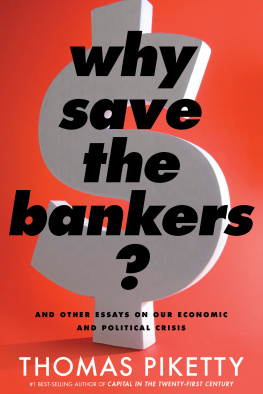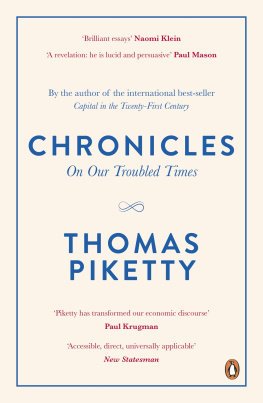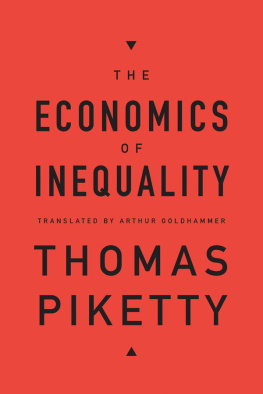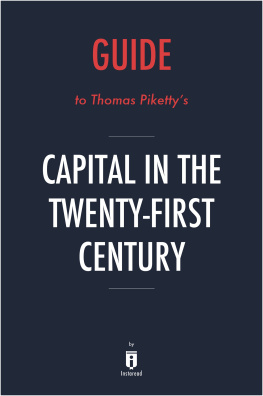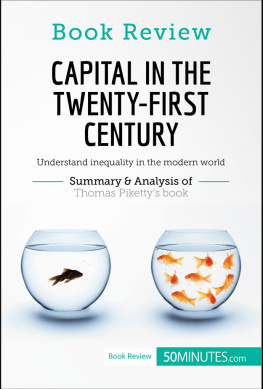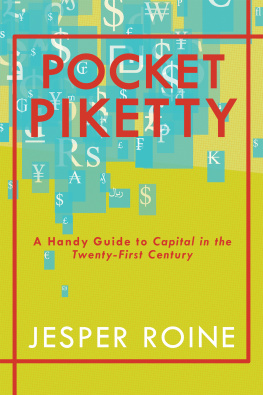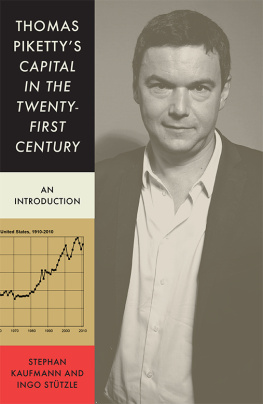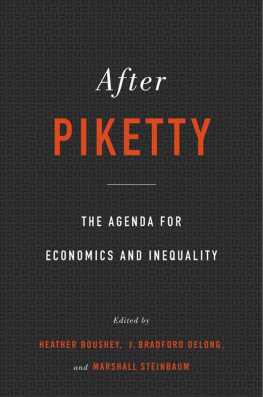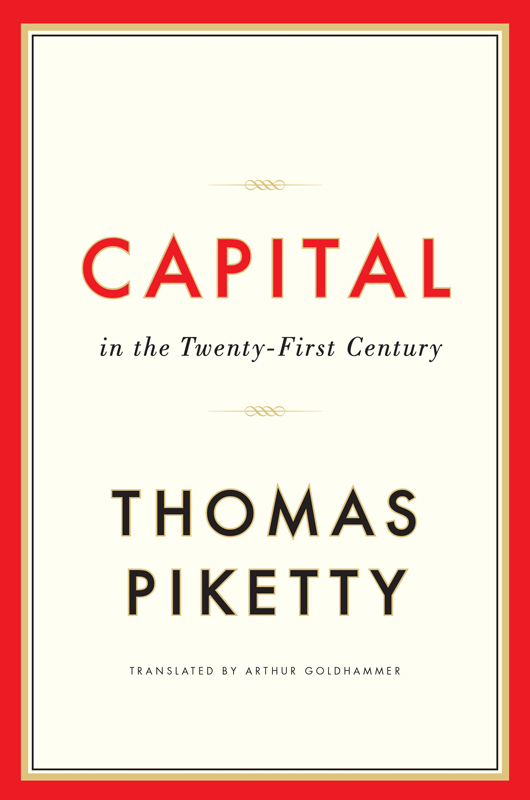Capital in the Twenty-First Century
CAPITAL IN THE
TWENTY-FIRST
CENTURY

Thomas Piketty
Translated by Arthur Goldhammer
The Belknap Press of Harvard University Press

CAMBRIDGE, MASSACHUSETTS LONDON, ENGLAND
2014
Copyright 2014 by the President and Fellows of Harvard College
All rights reserved
First published as Le capital au XXI sicle, copyright 2013 ditions du Seuil
Design by Dean Bornstein
Jacket design by Graciela Galup
The Library of Congress has cataloged the printed edition as follows
Piketty, Thomas, 1971
[Capital au XXIe sicle. English]
Capital in the twenty-first century / Thomas Piketty ; translated by Arthur Goldhammer.
pages cm
Translation of the authors Le capital au XXIe sicle.
Includes bibliographical references and index.
ISBN 978-0-674-43000-6 (alk. paper)
1. Capital. 2. Income distribution. 3. Wealth. 4. Labor economics. I. Goldhammer, Arthur, translator. II. Title.
HB501.P43613 2014
332'.041dc23
2013036024
Contents
Part One:
Part Two:
Part Three:
Part Four:
This book is based on fifteen years of research (19982013) devoted essentially to understanding the historical dynamics of wealth and income. Much of this research was done in collaboration with other scholars.
My earlier work on high-income earners in France, Les hauts revenus en France au 20e sicle (2001), had the extremely good fortune to win the enthusiastic support of Anthony Atkinson and Emmanuel Saez. Without them, my modest Francocentric project would surely never have achieved the international scope it has today. Tony, who was a model for me during my graduate school days, was the first reader of my historical work on inequality in France and immediately took up the British case as well as a number of other countries. Together, we edited two thick volumes that came out in 2007 and 2010, covering twenty countries in all and constituting the most extensive database available in regard to the historical evolution of income inequality. Emmanuel and I dealt with the US case. We discovered the vertiginous growth of income of the top 1 percent since the 1970s and 1980s, and our work enjoyed a certain influence in US political debate. We also worked together on a number of theoretical papers dealing with the optimal taxation of capital and income. This book owes a great deal to these collaborative efforts.
The book was also deeply influenced by my historical work with Gilles Postel-Vinay and Jean-Laurent Rosenthal on Parisian estate records from the French Revolution to the present. This work helped me to understand in a more intimate and vivid way the significance of wealth and capital and the problems associated with measuring them. Above all, Gilles and Jean-Laurent taught me to appreciate the many similarities, as well as differences, between the structure of property around 19001910 and the structure of property now.
All of this work is deeply indebted to the doctoral students and young scholars with whom I have been privileged to work over the past fifteen years. Beyond their direct contribution to the research on which this book draws, their enthusiasm and energy fueled the climate of intellectual excitement in which the work matured. I am thinking in particular of Facundo Alvaredo, Laurent Bach, Antoine Bozio, Clment Carbonnier, Fabien Dell, Gabrielle Fack, Nicolas Frmeaux, Lucie Gadenne, Julien Grenet, Elise Huilery, Camille Landais, Ioana Marinescu, Elodie Morival, Nancy Qian, Dorothe Rouzet, Stefanie Stantcheva, Juliana Londono Velez, Guillaume Saint-Jacques, Christoph Schinke, Aurlie Sotura, Mathieu Valdenaire, and Gabriel Zucman. More specifically, without the efficiency, rigor, and talents of Facundo Alvaredo, the World Top Incomes Database, to which I frequently refer in these pages, would not exist. Without the enthusiasm and insistence of Camille Landais, our collaborative project on the fiscal revolution would never have been written. Without the careful attention to detail and impressive capacity for work of Gabriel Zucman, I would never have completed the work on the historical evolution of the capital/income ratio in wealthy countries, which plays a key role in this book.
I also want to thank the institutions that made this project possible, starting with the cole des Hautes tudes en Sciences Sociales, where I have served on the faculty since 2000, as well as the cole Normale Suprieure and all the other institutions that contributed to the creation of the Paris School of Economics, where I have been a professor since it was founded, and of which I served as founding director from 2005 to 2007. By agreeing to join forces and become minority partners in a project that transcended the sum of their private interests, these institutions helped to create a modest public good, which I hope will continue to contribute to the development of a multipolar political economy in the twenty-first century.
Finally, thanks to Juliette, Dborah, and Hlne, my three precious daughters, for all the love and strength they give me. And thanks to Julia, who shares my life and is also my best reader. Her influence and support at every stage in the writing of this book have been essential. Without them, I would not have had the energy to see this project through to completion.
Social distinctions can be based only on common utility.
Declaration of the Rights of Man and the Citizen, article 1, 1789
The distribution of wealth is one of todays most widely discussed and controversial issues. But what do we really know about its evolution over the long term? Do the dynamics of private capital accumulation inevitably lead to the concentration of wealth in ever fewer hands, as Karl Marx believed in the nineteenth century? Or do the balancing forces of growth, competition, and technological progress lead in later stages of development to reduced inequality and greater harmony among the classes, as Simon Kuznets thought in the twentieth century? What do we really know about how wealth and income have evolved since the eighteenth century, and what lessons can we derive from that knowledge for the century now under way?
These are the questions I attempt to answer in this book. Let me say at once that the answers contained herein are imperfect and incomplete. But they are based on much more extensive historical and comparative data than were available to previous researchers, data covering three centuries and more than twenty countries, as well as on a new theoretical framework that affords a deeper understanding of the underlying mechanisms. Modern economic growth and the diffusion of knowledge have made it possible to avoid the Marxist apocalypse but have not modified the deep structures of capital and inequalityor in any case not as much as one might have imagined in the optimistic decades following World War II. When the rate of return on capital exceeds the rate of growth of output and income, as it did in the nineteenth century and seems quite likely to do again in the twenty-first, capitalism automatically generates arbitrary and unsustainable inequalities that radically undermine the meritocratic values on which democratic societies are based. There are nevertheless ways democracy can regain control over capitalism and ensure that the general interest takes precedence over private interests, while preserving economic openness and avoiding protectionist and nationalist reactions. The policy recommendations I propose later in the book tend in this direction. They are based on lessons derived from historical experience, of which what follows is essentially a narrative.


